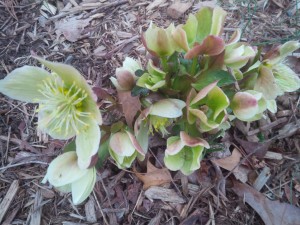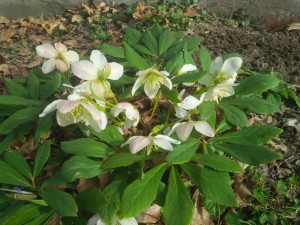 I hate to brag, but my hellebores are glorious. Little plants that I bought several years ago and installed in my front strip on a wing and a prayer have arrived at maturity. The gentle, open winter, with few really cold days and little snow has been a tonic for them, coaxing them into bud early and encouraging those buds to burst wide open. They persist in this scandalous flaunting of their lovely pinky-cream petals, even though March is coming in like a very breathy lion and pelting them with gusts.
I hate to brag, but my hellebores are glorious. Little plants that I bought several years ago and installed in my front strip on a wing and a prayer have arrived at maturity. The gentle, open winter, with few really cold days and little snow has been a tonic for them, coaxing them into bud early and encouraging those buds to burst wide open. They persist in this scandalous flaunting of their lovely pinky-cream petals, even though March is coming in like a very breathy lion and pelting them with gusts.
I never put hellebores in bouquets, because they do not seem to do well in the house. Occasionally I float one in a bowl of water and it lasts long enough to give me a few days of inspiration. The blooms work their magic better if I let the sight of them pull me out into the garden for a necessary blast of fresh air and inspiration. While I am there I take in the wonders of the various snowdrops, which are also beautiful this season. Over the years I have indulged in some semi-rare varieties that are so expensive that I have only purchased one or two bulbs at a time. Even those, like ‘Lady Elphinstone’, a displaced English aristocrat, have accepted the challenges of my garden and microclimates and bulked up. In fact, the two ‘Lady Elphinstone’ snowdrops, with their yellow tops, have been fruitful and multiplied into eight plants. Double-flowered snowdrops, which seem to increase more slowly, have worked at the job and produced offspring as well. I love looking at the rosettes of green petaloids in the center of each flower, framed by the trio of wing-like outer petals. The whole effect is joyous, but I might never have noticed if not for the enticement provided by the flashier hellebores. I clip a nosegay of various snowdrops, along with one of the lovely, tiger-striped ‘Katherine Hodgkin’ iris and bring them inside. Snug in the warm house and safely resting in an old, dark blue milk of magnesia bottle, they exude the sweet fragrance that is meant to attract the earliest, bravest of the spring pollinators.
I recommend making these small bouquets as a reminder of better things to come. Next time I go out, I’ll gather another diminutive arrangement incorporating the common violets that have opened up in the sunny raised bed by the garage. Lovers of manicured green lawns regard them as nuisance flowers, but I think they are perfect despite their tendency to proliferate.
M y fancy-pants, aspirational hellebores are in the backyard and I admire them too, but they live and thrive under better conditions. The ones in the strip are reasonably ordinary Helleborus x hybridus or Lenten roses. This year, their moment of glory has coincided with the arrival of Lent in the Christian calendar, so the name fits. They grow in the semi-shade under a middle-aged maple tree and its current leafless state allows them enough light to bloom now, while its leafy shade will shield them from the torrid summer heat later on. Once established the plants are absolutely carefree, with a single caveat. The large, leathery, palmate leaves persist through the winter, making them evergreen. But harsh weather inevitably takes its toll and the leaves that covered the earth in attractive mounds last fall end up looking tattered and careworn in the spring. As soon as the blooms open up every year, I head out and clip the old leaves, leaving the flowering stems and the emerging spring foliage to shine on their own. Some gardeners probably find this step tedious, but it only takes a few minutes to barber a mature plant and it makes an enormous difference in the overall appearance.
y fancy-pants, aspirational hellebores are in the backyard and I admire them too, but they live and thrive under better conditions. The ones in the strip are reasonably ordinary Helleborus x hybridus or Lenten roses. This year, their moment of glory has coincided with the arrival of Lent in the Christian calendar, so the name fits. They grow in the semi-shade under a middle-aged maple tree and its current leafless state allows them enough light to bloom now, while its leafy shade will shield them from the torrid summer heat later on. Once established the plants are absolutely carefree, with a single caveat. The large, leathery, palmate leaves persist through the winter, making them evergreen. But harsh weather inevitably takes its toll and the leaves that covered the earth in attractive mounds last fall end up looking tattered and careworn in the spring. As soon as the blooms open up every year, I head out and clip the old leaves, leaving the flowering stems and the emerging spring foliage to shine on their own. Some gardeners probably find this step tedious, but it only takes a few minutes to barber a mature plant and it makes an enormous difference in the overall appearance.
Besides, just as the sight of the hellebores from the front windows led me to the clumps of snowdrops, so clipping the hellebore foliage compels me to clean up the areas around the plants. This means raking up dead leaves, cutting back the remnants of last fall’s asters and other chores that I might not otherwise have done until weeks from now. Last weekend I went out with a rake on a Saturday morning, promising myself that I would only spend ten minutes grooming the front hellebores. I ended up depositing three big bags of yard waste by the curb for bulk pick-up. Most of my garden still looks awful, but that one tidied-up area gives me hope for the future.
When people ask me what to plant for early spring color, I always recommend the usual flowering bulbs. They are invaluable. Hellebores used to be less popular in American gardens, but they have gotten more attention over the last few decades and are now available just about everywhere. New strains and varieties come out every year. If you are adding to your garden, consider Lenten roses. They are one of spring’s great gateway plants.
